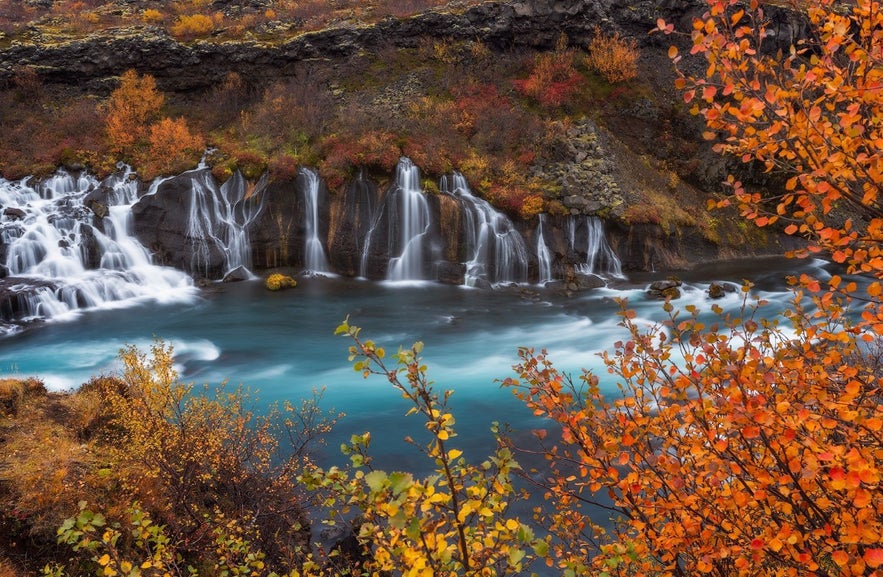
The fall season in Iceland generally starts at the end of August and last until late November. As the season transitions from summer to autumn, iconic attractions like the Golden Circle, the Jokulsarlon glacier lagoon, and waterfalls such as Skogafoss and Seljalandsfoss become even more magical against the autumn backdrop. This makes the fall months a fantastic time to explore what the country has to offer.
One of the major highlights of autumn in Iceland is the increased possibility of witnessing the northern lights, a breathtaking spectacle that lights up the dark night sky in a dance of colors. Additionally, fall is a great time for wildlife enthusiasts, as many bird species migrate through Iceland, and whale-watching tours offer a peak at the majestic marine life.
Why You Can Trust Our Content
Guide to Iceland is the most trusted travel platform in Iceland, helping millions of visitors each year. All our content is written and reviewed by local experts who are deeply familiar with Iceland. You can count on us for accurate, up-to-date, and trustworthy travel advice.
Despite the chill in the air, the thermal hot springs invite you for a warm soak amidst nature. Enjoy a visit to one of Iceland's many geothermal lagoons and pools, such as the world-renowned Blue Lagoon, Sky Lagoon, or Hvammsvik Hot Springs. Many of them are a short drive from the capital area, where you can also find varied hotels, apartments, and guesthouses to suit your needs. Here, you can find accommodation in Reykjavik when planning your trip.
Visiting Iceland in autumn promises an enchanting journey filled with unforgettable sights and experiences. Read on to find out everything you need to know about Iceland in the fall.
Things to Do in Iceland in Fall
 The fall is a great time to explore the many natural wonders that Iceland has to offer. There are fewer people visiting, the weather is generally mild, and there's still regular daylight available. Delve into the cultural heartbeat of Reykjavik and venture out on hikes and nature expeditions. There are exciting activities for everyone and no shortage of adventures in the Icelandic fall!
The fall is a great time to explore the many natural wonders that Iceland has to offer. There are fewer people visiting, the weather is generally mild, and there's still regular daylight available. Delve into the cultural heartbeat of Reykjavik and venture out on hikes and nature expeditions. There are exciting activities for everyone and no shortage of adventures in the Icelandic fall!
Explore the countryside: The best thing to do in Iceland in the fall is to explore the countryside in its autumn colors. To visit popular attractions, you can do a self-drive tour or go on a tour with an expert guide to get a deeper insight into the locations you're visiting.
Visit the Golden Circle: One of the most iconic tourist routes in Iceland is the Golden Circle. It encompasses attractions that are a must-see on any Iceland itinerary, such as the Geysir geothermal area, the Gullfoss waterfall, and Thingvellir National Park, a UNESCO World Heritage Site.
Go hiking: In early fall, Iceland is a hiker's delight, with trails winding through colorful landscapes. Choose from short one or two-hour trips that are great for families or experience multi-day hikes of varied difficulties.
 Go to festivals: Take part in the Icelandic culture by attending the festivals that take place during the fall season. From music, films, and food, there are many cultural events to choose from!
Go to festivals: Take part in the Icelandic culture by attending the festivals that take place during the fall season. From music, films, and food, there are many cultural events to choose from!
Go whale-watching: Fall in Iceland provides excellent opportunities for whale-watching. During a whale-watching tour, you're likely to spot minke whales, harbor porpoises, white-beaked dolphins, and even humpback whales off the coast!
Enjoy hot springs and geothermal lagoons: Fall is a great time to visit one of Iceland's many geothermal pools, lagoons, and hot springs, as they're likely to be less crowded. The crisp autumn air will also make soaking in the hot water particularly enjoyable.
Overall, a visit to Iceland in the fall offers a memorable experience with varied, exciting activities, beautiful nature, and insight into the Icelandic culture.
- See more: The 30 Best Hot Springs and Geothermal Pools in Iceland
- See more: The Best Guide to Whale Watching in Iceland
What To Know About Visiting Iceland in Fall
Budget-Friendly and Less Crowded

Photo from Wikimedia, Creative Commons, by Helgi Halldorsson. No edits made.
Fall in Iceland, extending from late August to late November, offers exciting cultural events and the chance to explore nature as it transitions from blooming summer into sleepy winter. You'll also have a more tranquil and intimate experience when visiting as the fall season sees a decrease in tourist numbers. This means you'll be able to explore iconic sites like the Golden Circle and the black sands of Reynisfjara beach without the bustling summer crowds.
The lower visitor numbers make visiting Iceland in fall more budget-friendly, as you're more likely to find lower prices for hotels and flights. We still recommend that you book accommodation well ahead of time to get more varied and affordable options to choose from.
Nature is Colorful
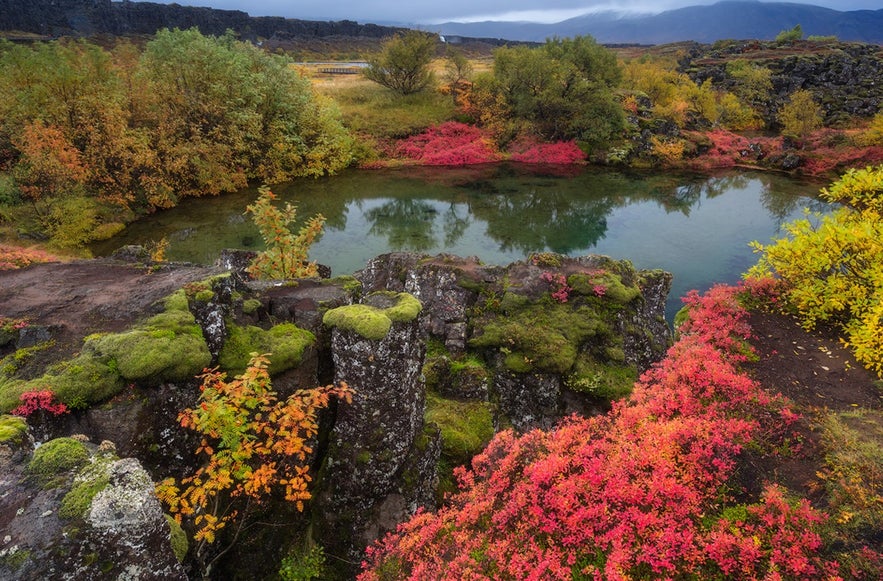 Early fall in Iceland brings a vibrant display of colors as the foliage changes from lush green to a spectrum of red, orange, and yellow. The birch forests and low-lying shrubs, in particular, transition into a symphony of warm hues, blanketing the hillsides and valleys. This provides a beautiful contrast against the rugged, often snow-tipped mountains and the blue of the countless lakes and rivers that pepper the countryside.
Early fall in Iceland brings a vibrant display of colors as the foliage changes from lush green to a spectrum of red, orange, and yellow. The birch forests and low-lying shrubs, in particular, transition into a symphony of warm hues, blanketing the hillsides and valleys. This provides a beautiful contrast against the rugged, often snow-tipped mountains and the blue of the countless lakes and rivers that pepper the countryside.
The mossy lava fields, a year-round spectacle, further enhance this colorful scene with their varied green shades. This colorful display transforms Icelandic nature and makes it a wonderful time to visit, especially for photographers!
Daylight Decreases
 As fall progresses in Iceland, daylight hours begin to decrease significantly. In early September, you can expect around 12 hours of daylight, providing ample time to explore. However, by late November, daylight can shrink to about 5 hours a day. This reduction can impact outdoor activities and travel plans, so it's important to plan accordingly.
As fall progresses in Iceland, daylight hours begin to decrease significantly. In early September, you can expect around 12 hours of daylight, providing ample time to explore. However, by late November, daylight can shrink to about 5 hours a day. This reduction can impact outdoor activities and travel plans, so it's important to plan accordingly.
Despite the shorter days, the long twilight periods create a soft, golden light which is great for photographs. Plus, the darker skies increase the chances of witnessing one of nature's most spectacular natural displays - the dancing colors of the northern lights.
The Northern Lights in Fall
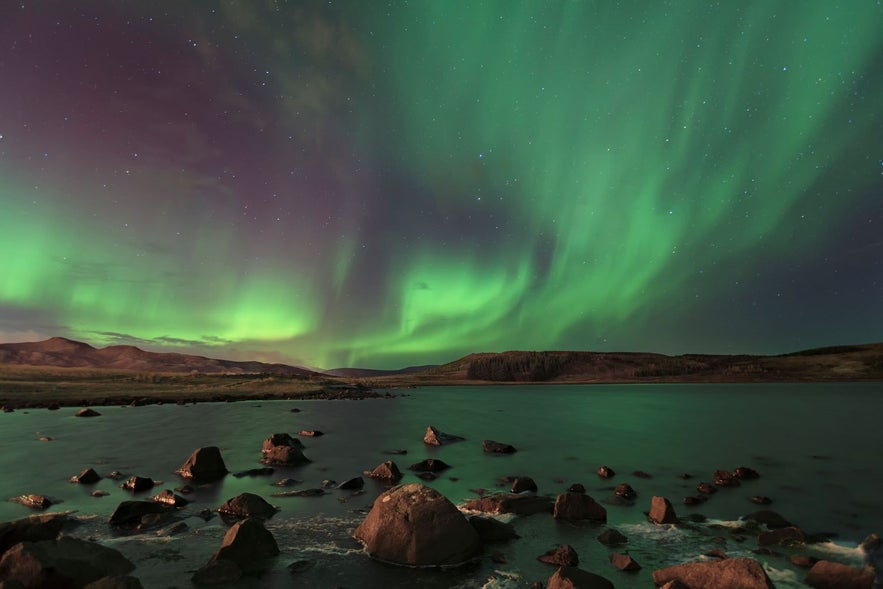 When visiting Iceland in late fall, you'll have a good chance of witnessing the northern lights. As the nights grow longer and darker in October and November, conditions become ideal for spotting them dancing in the sky. On a clear, dark night, you may see them swirl in hues of green, and at their strongest, they may appear pink, red, violet, or even white.
When visiting Iceland in late fall, you'll have a good chance of witnessing the northern lights. As the nights grow longer and darker in October and November, conditions become ideal for spotting them dancing in the sky. On a clear, dark night, you may see them swirl in hues of green, and at their strongest, they may appear pink, red, violet, or even white.
To increase your chances of viewing them, it's best to move away from the lights of Reykjavik into the Icelandic countryside, where light pollution is minimal. You can find specific northern lights hotels that have great locations for spotting them. Numerous northern lights tours are also available, providing transportation and guidance. You can also embark on a self-drive adventure and hunt for them yourself!
It's important to remember that seeing the northern lights depends on solar activity and weather conditions and is never guaranteed. Make sure to align your plans with the aurora forecast of the Icelandic Meteorological Office. Also, remember to dress warmly and be patient, and with a little luck, you'll witness one of nature's most astonishing displays!
The Fall Weather in Iceland
 In Iceland, the autumn season presents varied and unpredictable weather patterns. The daylight hours also decrease noticeably as the season progresses. In September, you can expect approximately 12 to 13 hours of daylight, reduced to around 5 hours by the end of November.
In Iceland, the autumn season presents varied and unpredictable weather patterns. The daylight hours also decrease noticeably as the season progresses. In September, you can expect approximately 12 to 13 hours of daylight, reduced to around 5 hours by the end of November.
The early part of fall in Iceland often sees mild temperatures, but as winter approaches, temperatures can drop below freezing, especially at night. Rainfall is common, and wind speeds can be high, adding a chill to the air. It's also possible to see early snowfall, especially in the northern parts of the country, towards the end of fall.
Average temperature in late August and September
In late August and September, the average temperature ranges from 46°F (8°C) to 59°F (15°C). It's not uncommon to experience even colder days and nights, and it's likely to be rainy and windy during this time. As Iceland's weather can be unpredictable, it's always wise to prepare for a range of weather conditions.
Average temperature in October
In October, Iceland experiences cooler temperatures as autumn progresses toward winter. The average high is around 45°F (7°C), while the average low can dip to 36°F (2°C). However, these temperatures can fluctuate, and it's not uncommon to experience colder conditions, especially at night.
Average temperature in November
November in Iceland marks the transition from autumn to winter, with average temperatures ranging between 30°F (-1°C) and 39°F (4°C). Days can be chilly and windy, and nights often drop below freezing. There's a chance of snow, especially in the north of Iceland.
The Icelandic Wind Warning System

Photo from Wikimedia, Creative Commons, by Steven Diaz. No edits made.
During the later autumn months, it's important for visitors to keep an eye on the Icelandic wind warning system because of the unpredictable weather. It provides real-time updates on wind speeds and weather conditions. The system helps travelers plan their journeys, advising when it's safe to drive or when to avoid certain areas due to high winds.
The Icelandic weather warning system is categorized by color-coded alerts:
- Yellow: Be alert and minimize travel.
- Orange: Weather can be hazardous, so avoid travel.
- Red: Severe weather. Stay inside and do not travel.
You may experience a weather warning during your autumn visit, especially in the later months. Therefore, make sure to check for updates on your trip and heed the warnings!
Driving in Iceland During Fall

Driving in Iceland during fall is generally safe and offers a great way to explore the country's landscapes at your own pace. Nonetheless, it's important to be prepared as the weather can be unpredictable, with possible rain, wind, and even early snow in late fall.
The Ring Road, which circles Iceland, provides access to many of the country's top sights and is usually well-maintained. However, some rural roads may be challenging, especially in adverse weather conditions, and highland roads will likely be closed. You can find information about road conditions on the Icelandic Road and Coastal Administration website, and always check the weather forecast before heading out.
We recommend checking out the SafeTravel website for information and preparation for driving in Iceland. If you're planning a road trip or an excursion into nature, make sure to submit a travel plan on their website. This is particularly important in case of an emergency as it will help the Icelandic Rescue Services find you. You can also sign up for safety notifications about weather and road conditions and download their app.
 When choosing a rental car for your fall adventure in Iceland, consider your itinerary and weather conditions. For trips on well-maintained paved routes or for staying within the city, a small rental car will suffice. If you plan to venture off the main paved roads, it's generally the safest option to rent a 4x4 vehicle, especially as unpredictable weather might bring rain or early snow.
When choosing a rental car for your fall adventure in Iceland, consider your itinerary and weather conditions. For trips on well-maintained paved routes or for staying within the city, a small rental car will suffice. If you plan to venture off the main paved roads, it's generally the safest option to rent a 4x4 vehicle, especially as unpredictable weather might bring rain or early snow.
Remember, off-road driving is illegal in Iceland as it damages the fragile ecosystem and will result in high fines. Always adhere to speed limits, wear seatbelts, and never stop your car on the road to take photographs, especially on the Ring Road. Drive responsibly and enjoy the journey!
What to Pack for Fall in Iceland
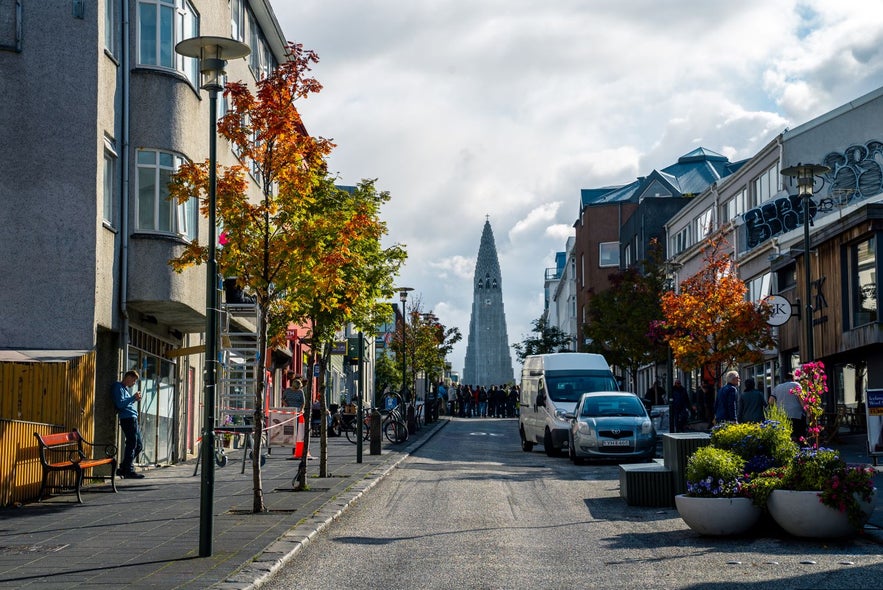 Packing for a fall trip to Iceland requires planning for diverse weather conditions. The season can experience mild days and chilly nights, with chances of rain and wind. Here are some essential items to pack for your trip to Iceland in fall:
Packing for a fall trip to Iceland requires planning for diverse weather conditions. The season can experience mild days and chilly nights, with chances of rain and wind. Here are some essential items to pack for your trip to Iceland in fall:
-
Layered Clothing: Temperature fluctuations are common, so pack layers. Start with thermal base layers, add a warm middle layer such as a fleece or wool sweater, and a waterproof and windproof outer layer.
-
Warm Accessories: Hats, gloves, and scarves are essential to protect against the cold. A good pair of thermal socks is also recommended.
-
Footwear: Waterproof hiking boots are necessary for outdoor activities. Make sure they're comfortable for long walks and provide good ankle support.
-
Rain Gear: Given the likelihood of rain, pack a waterproof jacket and consider rain pants. A rain cover for your backpack can also be handy. Don't bother bringing an umbrella as it will most likely be too windy to use one.
-
Swimwear: Don't forget your swimsuit to enjoy Iceland's geothermal pools and hot springs!
-
Photography Equipment: For capturing beautiful landscapes and the northern lights, bring a good camera. A tripod can be useful for long-exposure shots of the aurora.
Camping in Iceland in Fall
 Camping in Iceland during fall can be an adventurous way to experience Icelandic nature, but it requires thorough preparation due to the unpredictable weather. It's best done in early fall while the weather is still mild and campsites are open. As the season progresses into October and November, most campsites close due to colder weather and fewer daylight hours.
Camping in Iceland during fall can be an adventurous way to experience Icelandic nature, but it requires thorough preparation due to the unpredictable weather. It's best done in early fall while the weather is still mild and campsites are open. As the season progresses into October and November, most campsites close due to colder weather and fewer daylight hours.
If you plan to camp, be prepared for a range of conditions. Waterproof and windproof tents, warm sleeping bags, and layered clothing are essential. You can also rent a campervan for the most convenient and safe camping experience.
Remember, wild camping is restricted in Iceland to protect the fragile ecosystem. Always use designated campsites, including if you're sleeping in a campervan and respect the environment.
Activities and Events in Iceland in Fall
Icelandic Festivals in Fall

Photo from Wikimedia, Creative Commons, by Helgi Halldorsson. No edits made.
While summer is the height of the festival season in Iceland, there are also many events to choose from in the fall months. Each one celebrates an aspect of the country's culture and is a great way to immerse yourself in the Icelandic music, film, and art scene.
- Reykjavik Culture Night, or Menningarnott, is held in August and marks the end of summer and the beginning of fall. This festival celebrates Icelandic culture with a mix of art, concerts, dance, and cuisine, as the city's streets and public spaces brim with life and festivity throughout the day and night. Entry to events is usually free, and the night concludes with a beautiful fireworks show.
- Reykjavik Gay Pride is held annually on the second weekend in August and celebrates love, equality, and LGBTQ+ rights. This week-long event features the colorful pride parade, along with concerts, workshops, and exhibitions, attracting tens of thousands of visitors from Iceland and around the globe.
- The Festival of Lights, or Ljosanott, takes place during the first weekend of September in the town of Keflavik. The highlight of the night is a street concert featuring varied artists, along with a beautiful firework show that illuminates the night sky.
- The Reykjavik International Film Festival, or RIFF, is another prominent autumn event. Running for 11 days and usually starting at the end of September, RIFF features a broad spectrum of films from over 40 countries, emphasizing independent filmmaking and innovative storytelling.
- Iceland Airwaves, typically held in November, is an internationally acclaimed music festival attracting a myriad of artists from diverse genres. Featuring both new talent and well-known, established artists, this festival turns Reykjavik into a bustling hub of music and entertainment, with performances taking place in various venues across the city.
With such diverse festivals and events, fall in Iceland offers a culturally enriching experience. Make sure to check out some of these celebrations to make the most of your autumn visit to Iceland!
- See more: The Top 20 Festivals in Iceland
- See more: The Ultimate Guide to Gay Iceland
Midgard Convention
 If you happen to be visiting Iceland in early September and are passionate about video games, board games, tabletop games, or a fan of comics, TV shows, and movies, then don't miss out on the Midgard Convention. This annual celebration of all things "nerdy" takes place over a weekend in the Laugardalsholl sport center in central Reykjavik and welcomes everyone, from superfans to those who are simply curious.
If you happen to be visiting Iceland in early September and are passionate about video games, board games, tabletop games, or a fan of comics, TV shows, and movies, then don't miss out on the Midgard Convention. This annual celebration of all things "nerdy" takes place over a weekend in the Laugardalsholl sport center in central Reykjavik and welcomes everyone, from superfans to those who are simply curious.
You can explore the vast exhibition space with many fandoms represented and take part in panels, discussions, workshops, games, and competitions. You can also try your hand at a scavenger hunt and see Viking fights.
This can be a great event if you're traveling with children, as there are family-friendly activities. There's even a special cosplay competition for kids!
Whether you're traveling alone, with friends, or with family, you're sure to have fun during your visit, so include the Midgard convention in your travel itinerary if you're visiting in early September. Make sure to buy your Midgard tickets in advance so you don't miss out.
The Imagine Peace Tower

Photo from Wikimedia, Creative Commons, by Helgi Halldorsson. No edits made.
On the island of Videy, off the coast of Reykjavik, you'll find the Imagine Peace Tower. It was created by artist Yoko Ono in 2007 to honor the memory of John Lennon. It illuminates the night sky from October 9th (John Lennon's birthday) to December 8th (the anniversary of his passing).
The tower's brilliant beam of light signifies hope, unity, and a call for global harmony. There are generally events going on in Videy when the tower is turned on, which are open to everyone. The light can also be spotted in the sky from all over the capital area.
You can visit Videy throughout the year, and it can be especially nice in summer. The island is part of the Reykjavik City Museum Collective and boasts many other artworks and historic locations, such as the Videy House, one of the oldest buildings in Iceland.
Icelandic Language Day

Icelandic Language Day is celebrated on November 16th and is a special occasion that honors the Icelandic language and its cultural significance. This date coincides with the birthday of poet and national hero Jonas Hallgrimsson, and the day is marked with various events and activities that promote the Icelandic language.
Icelandic Language Day serves as a reminder of the importance of preserving and cherishing the language. It also highlights the efforts made by the Icelandic nation to maintain its language in a world heavily influenced by globalization. If you're planning on visiting during this time, consider honoring the day by diving into Icelandic culture and learning a bit of the language yourself!
- See more: Icelandic Alphabet and Language Basics
Oktoberfest in Reykjavik

Photo from Wikimedia, Creative Commons, by Christine Zenino. No edits made.
While not a traditional Icelandic event by any means, Oktoberfest has found its way to Iceland, adding a Bavarian touch to the chilly autumn. Held from September to early October, you can find bars and restaurants celebrating with special offers, so make sure to keep an eye out!
If you're a beer enthusiast planning to travel around Iceland during Oktoberfest, it may be the most appropriate time to try the fun Bjorbodin Beer Spa near the town of Dalvik! You can book your Beer Spa tickets here when planning your autumn trip to Iceland.
Visiting Rettir
 When visiting Iceland in autumn, you may get a chance to see "rettir", or sheep round-up. Held annually at the beginning of September, it brings together locals to gather sheep from the mountains. Sheep generally roam free all over the country during the summer and need to be herded together and sorted, so they can be brought back inside for shelter over the colder months.
When visiting Iceland in autumn, you may get a chance to see "rettir", or sheep round-up. Held annually at the beginning of September, it brings together locals to gather sheep from the mountains. Sheep generally roam free all over the country during the summer and need to be herded together and sorted, so they can be brought back inside for shelter over the colder months.
You can witness traditional herding techniques and may even be able to participate in sorting and marking the sheep. Sheep round-ups take place all over the countryside, and attending offers a glimpse into the agricultural customs of Iceland.
Harvesting Wild Berries and Mushrooms

Photo from Wikimedia, Creative Commons, by Leonora (Ellie) Enking. No edits made.
The Icelandic autumn season brings an abundance of wild berries, and you're likely to see many locals in the hillsides collecting them in early fall. There's even a word for this in Icelandic, as people say they're going to "berjamo" when they're going berry picking. You'll find black crowberries and blueberries all over the country, and make sure to pick some as they pair amazingly with clean skyr mixed with some sugar and cream!
Additionally, you can go foraging for different mushrooms around Iceland, though it's important to educate oneself on proper identification to be safe. Also, as always, make sure to respect the environment and follow sustainable foraging practices.
If you'd like to try your hand at foraging in Iceland, it's best to choose accommodation with access to a kitchen when planning your trip. That way, you can incorporate your ingredients into a delicious homemade meal! Here, you can book a holiday apartment or book a cottage surrounded by the nature of Iceland.
In summary, Iceland's fall season is a time of diverse celebrations and a fantastic time to explore the county. With varied events that offer something for every cultural interest and artistic taste, you're likely to have a great time when visiting!
FAQs about Iceland in Fall
 Here you'll find answers to the most frequently asked questions about visiting Iceland in fall.
Here you'll find answers to the most frequently asked questions about visiting Iceland in fall.
When is the best time to visit Iceland in the fall?
Mid-September to October is ideal for visiting Iceland for the optimal fall experience. You can experience vibrant fall colors and lesser crowds while still making the most out of outdoor activities.
Is fall a good time to see the northern lights in Iceland?
Yes, late fall is a great time to see the northern lights in Iceland, specifically in October and November. As the nights get progressively longer and darker, the quality of viewing conditions increases.
Are Icelandic roads and attractions open during the fall?
Most roads and attractions remain open. There may be temporary closures due to weather, though this mostly occurs in late autumn. Highland roads close in the fall, but the exact timing varies depending on weather conditions each year. Always check road conditions and weather forecasts before traveling.
What should I wear in Iceland in the fall?
Layered clothing is recommended, including a waterproof and windproof outer layer. Don't forget warm accessories like scarves, hats, gloves, and thermal socks.
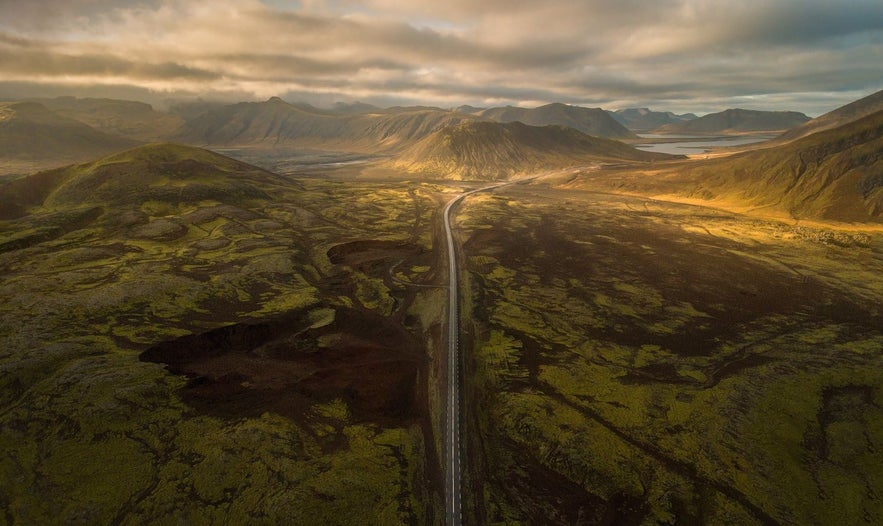
What kind of car should I rent in Iceland in fall?
A standard car is generally sufficient for driving on Iceland's main roads in fall. However, if you're planning to explore more remote areas or expect heavy rain or early snow, a 4x4 vehicle might be more appropriate.
What are the hiking conditions in Iceland in fall?
Hiking in fall offers beautiful autumnal landscapes, but trails can be slippery due to rain or frost. Daylight hours decrease, so plan accordingly. Always check weather conditions and trail status before setting off, and pack warm, waterproof clothing.
What wildlife can I see in Iceland in fall?
You'll be able to see whales along the coast of Iceland, and whale-watching tours are operational all year round. Arctic foxes starting to grow their winter coats, though they can be hard to spot. You may see reindeer in the Eastfjords, and if you're visiting at the start of fall, you might be able to spot puffins before they migrate to warmer climates.
Summary of Iceland in Fall
 In conclusion, visiting Iceland in autumn offers an exciting experience for travelers as the season showcases Iceland's natural beauty in a different light. While the weather can be unpredictable, the changing foliage and the smaller crowds make it a great time to explore the country.
In conclusion, visiting Iceland in autumn offers an exciting experience for travelers as the season showcases Iceland's natural beauty in a different light. While the weather can be unpredictable, the changing foliage and the smaller crowds make it a great time to explore the country.
From scenic hikes through nature to relaxing in geothermal pools, there are plenty of activities to enjoy during fall in Iceland. The cultural events and festivals add an extra layer of excitement, and you may get a chance to spot the magical northern lights. So bundle up, keep your eyes on the sky, and prepare to be enchanted by Iceland in autumn!
Are you planning on a fall trip to Iceland? What are you most looking forward to experiencing? Will you visit one of Iceland's many festivals? If you have visited Iceland in the fall months, tell us about it in the comments below!













